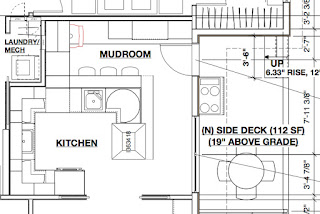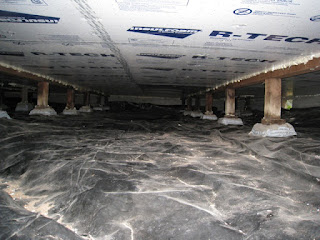Kitchen and Mudroom
We kept the same total footprint of the house — interior usable space of 1,569 square feet. The room layout stayed the same, with the exception of the kitchen where we knocked down the wall between the kitchen and the mudroom and took the space from the bedroom closet.
Old layout
The original house had an exterior door into the mudroom that held the washer and dryer. The kitchen had 3 openings. One opening between the kitchen and the mudroom, a door leading to the hallway and another door into the dining room. The sink faced the west windows and at the left end of the countertop was the ventilated vegetable storage (aka California Cooler) where the exterior wall had vents. The gas-fired water heater was in the south-east corner next to the gas stove and range. A ceiling fan vented to the outside could be operated by pulling the chain. The north wall had a cute built-in cabinet.
The new layout

The new layout still has a mudroom, but there is no longer a wall separating the mudroom from the kitchen. The door into the mudroom extends out to a small deck where we’ll have a outdoor gas barbecue. A bench and cabinet is placed on the south wall and this is where we’ll hang out coats and take our shoes off. Looking straight in from the mudroom door you’ll see a little desk area where we intend to do paper mail sorting, recipe lookup and such. Pantry is next to the desk. The breakfast bar wraps around the outside of the sink, countertop and cooktop. There is no longer a door to the hallway and the cabinets cover the east wall. We have 2 sinks in the hopes of having 2 cooks in the kitchen working side by side in peace. The door to the dining room changed from the swinging type to a larger pocket door.
Here are some “before photos” of the original kitchen.
Mudroom: As viewed from the kitchen. Washer and dryer took up most of the space in the mudroom. Note the bead board wall behind the washer and dryer. Speaking of wall, the kitchen had the lovely funky plastic fake brick thing above the wainscoting.
Kitchen sink: The kitchen sink and the countertop was a little taller than the standard countertop height I’m familiar with. The windows above the sink and countertop provided pretty afternoon light. On the right side of the sink is a vegetable storage space known as “California Cooler.”
California Cooler: The upper and lower vents next to the lattice fence provided the cool breeze to flow through the wire mesh shelves to keep the fruits and vegetables fresh. If you’re curious about the California Cooler, read what another blogger wrote about them.
Fridge, Stove, Water Heater: The gas water heater in the kitchen was literally placed in the center of the house. The seismic strapping prevented the use of the cool “ironing board feature,” (we think). The gas stove/oven was a O’Keefe & Merritt from the 1950’s. It was very cute but we didn’t want to have any gas combustion appliances in the house so it was sold on Craigslist. The refrigerator was only about 5 years old and it too got sold on Craigslist.
Hidden Chimney: When our designer took measurements of the house there was a small amount of unaccounted space between the closet and the kitchen. This mystery was solved during the deconstruction where a chimney was revealed in the wall cavity behind the water heater.
Upper Cabinets: A cute glass door showed what was stored in the cabinets.
Lower Drawers and Bins: Below the upper cabinet was a countertop covered in blue linoleum. These bins in the kitchen must have been used to store flour or some grains back in 1920’s. As charming as these were we chose not to keep them.
Here are the “work-in-progress photos” of the new kitchen:
Mudroom Bench and Cabinets: The door to the mudroom is to the right of the bench and we’ll probably use this door 90% of the time. So, we’ll come in through the door and kick off our shoes then place them under the bench. Next hang the jacket on the hook. If we were riding our bikes and we had helmets and gloves they may go in the upper cabinet.
Desk and Communication Center: The little desk in the corner of the mudroom will be used for day-to-day household paper and communication. The slots above the desk will be used to sort mail. Under the desk will have network devices and the desk will have a small computer that will display the house monitoring data (energy consumption, temperature and humidity). To the left of the desk is the pantry.
Pantry: Next to the desk is the pantry with pull-out drawers.
Upper Cabinets: The kitchen cabinets are made of cherry wood in Shaker style with soft-close mechanism for doors and drawers. Crown moulding a the top that bridge gaps between the cabinet and the soffit adds just the right touch to make the kitchen have the arts and crafts feel without being too fussy. Loughridge Cabinets of Scotts Valley made these and we’re really happy with their workmanship.
Countertop: In these two photos you’ll see Taylor applying adhesive to the top of the cabinet then fitting the carefully cut PaperStone countertop with Jacob’s help. We looked at various materials for the countertop and the breakfast bar. Going to a retail shop where you can see green product samples as well as get information from knowledgeable staff made a big difference. We shopped for the countertops and breakfast bar in the spring of 2011 by going to Ecohaus in San Francisco (now closed) and GreenSpace in Santa Cruz (still open!!) and looked at many different green countertop products.
There are many different types of materials and color choices within each product line. If you’re considering the pros and cons of different materials I invite you to take a look at the Countertop page of Green Remodel Forum where there is a detailed description of various materials by attributes. Our selection criteria came down to 2 key points: sustainability of the material and aesthetic fit with the California Bungalow style. We chose a product called PaperStone in mocha color for the countertop. It’s a sensible product that is made with FSC certified post consumer paper product held together with petroleum-free resin. Details of the PaperStone material can be found here.
Tile: For the kitchen backsplash we used the Debris series from Fireclay Tile which is made with 60% recycled material in the Bay Area. While many distributors carry Fireclay tile we liked visiting the showroom in San Jose. Picking out a dozen different sample tiles and taking it back to our kitchen to see which best matched the color scheme was very helpful.
Re-using the bead boards: Remember the bead boards on the wall of the original mudroom? They were re-used to surface the breakfast bar.









